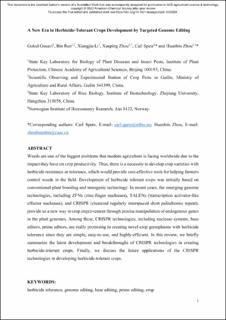| dc.contributor.author | Gosavi, Gokul | |
| dc.contributor.author | Ren, Bin | |
| dc.contributor.author | Li, Xiangjiu | |
| dc.contributor.author | Zhou, Xueping | |
| dc.contributor.author | Spetz, Carl | |
| dc.contributor.author | Zhou, Huanbin | |
| dc.date.accessioned | 2023-03-20T12:42:34Z | |
| dc.date.available | 2023-03-20T12:42:34Z | |
| dc.date.created | 2022-02-11T20:06:36Z | |
| dc.date.issued | 2022 | |
| dc.identifier.citation | ACS Agricultural Science & Technology. 2022, 2 (2), 184-191. | en_US |
| dc.identifier.issn | 2692-1952 | |
| dc.identifier.uri | https://hdl.handle.net/11250/3059264 | |
| dc.description.abstract | Weeds are one of the biggest problems that modern agriculture is facing worldwide due to the impact they have on crop productivity. Thus, there is a necessity to develop crop varieties with herbicide resistance or tolerance, which would provide cost-effective tools for helping farmers control weeds in the field. Development of herbicide-tolerant crops was initially based on conventional plant breeding and transgenic technology. In recent years, the emerging genome technologies, including ZFNs (zinc-finger nucleases), TALENs (transcription activator-like effector nucleases), and CRISPR (clustered regularly interspaced short palindromic repeat), provide us a new way for crop improvement through precise manipulation of endogenous genes in the plant genomes. Among these, CRISPR technologies, including nuclease systems, base editors, and prime editors, are really promising in creating novel crop germplasms with herbicide tolerance as they are simple, easy to use, and highly efficient. In this review, we briefly summarize the latest development and breakthroughs of CRISPR technologies in creating herbicide-tolerant crops. Finally, we discuss the future applications of CRISPR technologies in developing herbicide-tolerant crops. | en_US |
| dc.language.iso | eng | en_US |
| dc.publisher | American Chemical Society | en_US |
| dc.title | A New Era in Herbicide-Tolerant Crops Development by Targeted Genome Editing | en_US |
| dc.title.alternative | A New Era in Herbicide-Tolerant Crops Development by Targeted Genome Editing | en_US |
| dc.type | Peer reviewed | en_US |
| dc.type | Journal article | en_US |
| dc.description.version | acceptedVersion | en_US |
| dc.rights.holder | © 2022 American Chemical Society | en_US |
| dc.source.pagenumber | 184-191 | en_US |
| dc.source.volume | 2 | en_US |
| dc.source.journal | ACS Agricultural Science & Technology | en_US |
| dc.source.issue | 2 | en_US |
| dc.identifier.doi | 10.1021/acsagscitech.1c00254 | |
| dc.identifier.cristin | 2000700 | |
| dc.relation.project | Norges forskningsråd: 287794 | en_US |
| cristin.ispublished | true | |
| cristin.fulltext | postprint | |
| cristin.qualitycode | 1 | |
